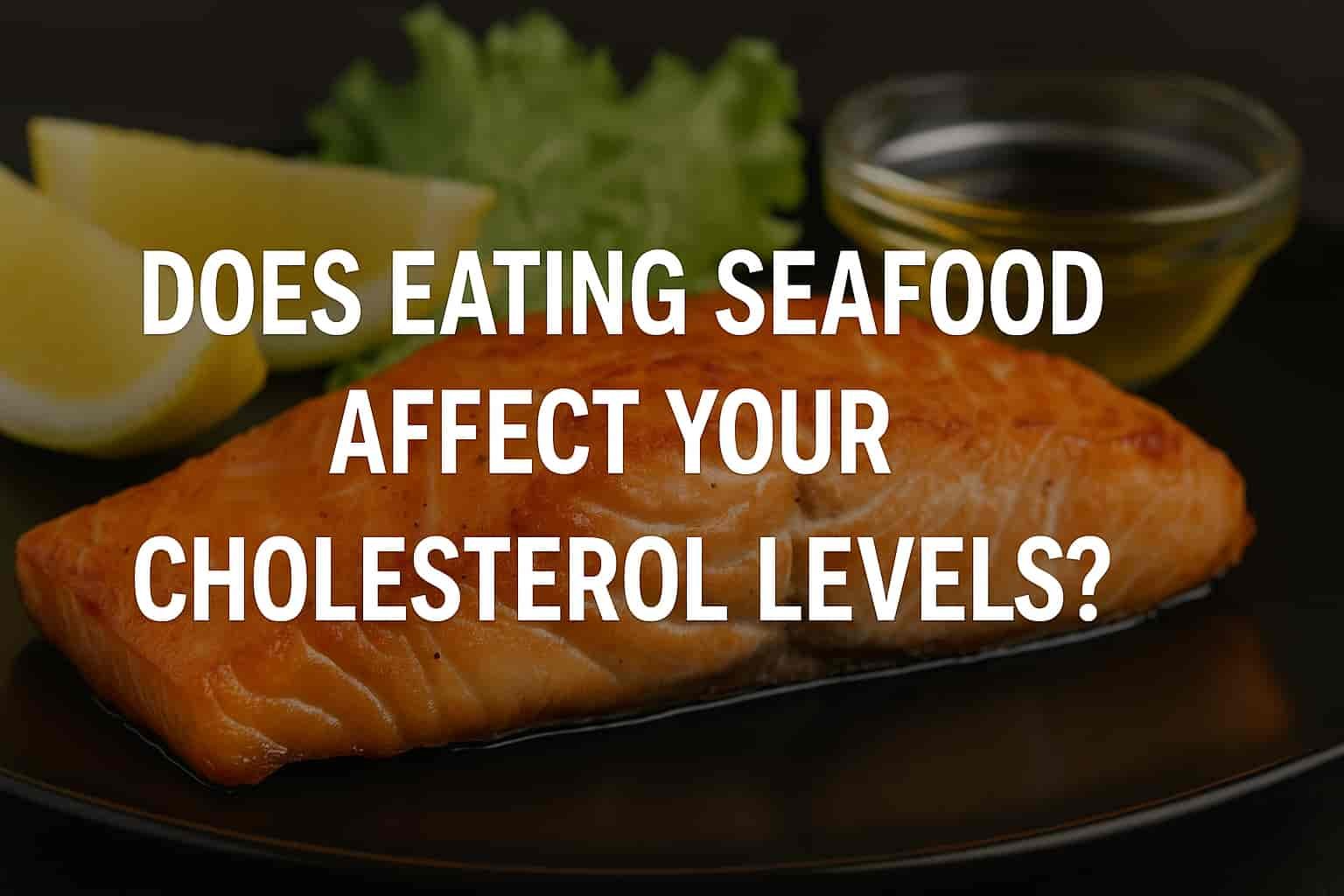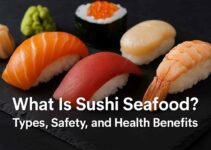Seafood holds a prominent position in heart-healthy diets, often praised for its rich content of omega-3 fatty acids and lean protein. However, many individuals remain uncertain about its impact on cholesterol levels. With cardiovascular diseases accounting for 32% of global deaths annually, understanding how dietary choices affect heart health is critical.
This article directly answers whether consuming seafood increases cholesterol, which types to avoid if you’re managing cholesterol levels, and which seafood options actively support heart health. Scientific studies and expert guidelines are used to provide clear, actionable advice without speculation.
By the end of this article, you will know which seafood is safe for high-cholesterol individuals, how omega-3 fatty acids influence cholesterol, and why cooking methods play a significant role in determining the health impact of your seafood dishes. For more information on selecting quality seafood, read our guide on How to Choose Fresh Seafood at the Market.
Contents
- 1 Does Eating Seafood Increase Your Cholesterol Levels?
- 2 Which Types of Seafood Are High in Cholesterol?
- 3 Which Types of Seafood Are Low in Cholesterol and Heart-Friendly?
- 4 How Do Omega-3 Fatty Acids in Seafood Affect Cholesterol?
- 5 Is It Safe for People with High Cholesterol to Eat Seafood?
- 6 How Does Cooking Method Influence the Cholesterol Impact of Seafood?
- 7 Are There Any Seafood-Based Diets That Help Manage Cholesterol Levels?
- 8 What Are the Healthiest Portion Sizes of Seafood to Support Heart Health?
- 9 Are There Any Risks of Completely Eliminating Seafood to Control Cholesterol?
- 10 How Many Servings of Fatty Fish Per Week Are Ideal for Cholesterol Control?
- 11 What Portion Sizes Should People with High Cholesterol Limit Themselves To?
Does Eating Seafood Increase Your Cholesterol Levels?
Eating seafood does not universally increase cholesterol levels. The impact depends on the type of seafood and the frequency of consumption. According to the American Heart Association, consuming fatty fish like salmon twice a week can lower LDL (bad cholesterol) and increase HDL (good cholesterol) due to high omega-3 content.
However, seafood such as shrimp and squid contains higher dietary cholesterol. For example, a 100-gram serving of shrimp contains approximately 189 mg of cholesterol, which is 63% of the recommended daily limit of 300 mg. Despite this, clinical studies show that the cholesterol from seafood does not raise blood cholesterol as significantly as saturated fats found in red meat and processed foods.
Key Insight: Prioritize seafood rich in omega-3 and low in saturated fats to maintain healthy cholesterol levels.
Which Types of Seafood Are High in Cholesterol?
There are 5 primary types of seafood high in cholesterol: shrimp, squid, octopus, lobster, and crab.
- Shrimp: Contains 189 mg of cholesterol per 100 grams.
- Squid (Calamari): Contains 233 mg of cholesterol per 100 grams.
- Octopus: Contains 95 mg of cholesterol per 100 grams.
- Lobster: Contains 70 mg of cholesterol per 100 grams.
- Crab: Contains 55 mg of cholesterol per 100 grams.
Despite their high cholesterol content, these seafood types are also low in saturated fat. Clinical trials published in the American Journal of Clinical Nutrition confirm that dietary cholesterol from seafood has a less pronounced effect on blood cholesterol than once believed.
Recommendation: Limit high-cholesterol seafood to no more than one serving per week if you are managing high LDL levels.
Which Types of Seafood Are Low in Cholesterol and Heart-Friendly?
Seafood low in cholesterol and rich in heart-friendly nutrients includes salmon, sardines, mackerel, and trout.
- Salmon: Contains only 55 mg of cholesterol per 100 grams and is high in omega-3 fatty acids (1.8 grams per serving).
- Sardines: Provide 40 mg of cholesterol per 100 grams and offer significant heart-protective EPA and DHA.
- Mackerel: Contains 70 mg of cholesterol but delivers over 2 grams of omega-3s, which actively reduce LDL cholesterol.
- Trout: Offers 60 mg of cholesterol with substantial vitamin D and omega-3 content.
Plant-based seafood alternatives such as algae-based products also provide EPA and DHA without any cholesterol, making them ideal for vegans and individuals with strict cholesterol restrictions.
Conclusion: For cholesterol management, select fatty fish rich in omega-3 and limit intake of shellfish known for higher cholesterol content.
How Do Omega-3 Fatty Acids in Seafood Affect Cholesterol?
Omega-3 fatty acids directly lower triglyceride levels and help raise HDL (good cholesterol). According to a 2021 meta-analysis published in the Journal of Clinical Lipidology, consuming at least 2 grams of EPA and DHA daily reduces triglycerides by up to 25%.
Omega-3s, primarily found in fatty fish such as salmon, sardines, and mackerel, have a dual effect:
- Decrease triglycerides by reducing liver fat production.
- Increase HDL cholesterol by up to 10% with consistent intake over 12 weeks.
While omega-3s have minimal direct impact on lowering LDL cholesterol, they prevent LDL particles from oxidizing—a key factor in reducing plaque buildup in arteries.
Key Recommendation: Include at least two servings of fatty fish per week or take purified fish oil supplements providing a minimum of 2,000 mg of combined EPA and DHA daily for optimal heart health.
Is It Safe for People with High Cholesterol to Eat Seafood?
People with high cholesterol can safely consume seafood, provided they choose low-cholesterol, high-omega-3 varieties.
The National Cholesterol Education Program recommends avoiding seafood high in saturated fats and cholesterol, such as fried shrimp or butter-rich seafood dishes. Instead, opt for grilled, steamed, or baked preparations using heart-healthy oils like olive oil.
Cardiologist-Approved Guidelines for Seafood Consumption:
- 2–3 servings of fatty fish weekly (e.g., salmon, sardines, mackerel).
- Limit high-cholesterol seafood (shrimp, squid) to once per week.
- Avoid deep-fried seafood entirely due to increased trans fats.
Clinical Data: A 6-month dietary intervention by the American Heart Association showed that replacing red meat with seafood reduced LDL cholesterol by 15% in participants with hypercholesterolemia.
Conclusion: Seafood is not only safe but beneficial for high-cholesterol individuals when consumed wisely.
How Does Cooking Method Influence the Cholesterol Impact of Seafood?
Cooking methods significantly affect how seafood impacts cholesterol levels.
- Grilling and Steaming: Preserve omega-3 content and avoid adding unhealthy fats.
- Baking: Allows controlled fat use, ideal when using olive oil or avocado oil.
- Frying: Increases saturated fat and trans fat intake, which raises LDL cholesterol by up to 20%, according to the European Journal of Clinical Nutrition.
Key Data: Frying shrimp increases its saturated fat content by over 35%, and breaded fried fish dishes raise the total calorie count by 50% or more.
Best Practice: Prepare seafood using grilling, steaming, or baking to retain its heart-friendly benefits. Avoid frying and heavy sauces that contribute to unhealthy fat intake.
Are There Any Seafood-Based Diets That Help Manage Cholesterol Levels?
The Mediterranean and Pescatarian diets are scientifically proven to help manage cholesterol levels through regular seafood consumption.
- Mediterranean Diet: A clinical trial published in The New England Journal of Medicine found that participants following the Mediterranean diet reduced their LDL cholesterol by 14% and increased HDL by 6% over a 12-month period. This diet emphasizes fatty fish like salmon, sardines, and anchovies, combined with extra virgin olive oil, nuts, and whole grains.
- Pescatarian Diet: This plant-based diet includes seafood as the primary protein source. A 2020 study from the Journal of Nutrition reported that individuals following a pescatarian diet had 13% lower LDL cholesterol levels compared to meat-eaters after six months.
Conclusion: If you’re aiming to control cholesterol naturally, these diets provide structured, sustainable approaches that integrate heart-healthy seafood while minimizing high-cholesterol meats.
What Are the Healthiest Portion Sizes of Seafood to Support Heart Health?
The American Heart Association recommends consuming 2–3 servings of fatty fish per week, with each serving being 100–150 grams.
- For high cholesterol individuals: Limit servings of high-cholesterol seafood like shrimp and squid to one 100-gram serving per week.
- For heart-friendly seafood: Safely consume up to three 150-gram servings of salmon, sardines, or mackerel weekly to maximize omega-3 intake.
Visual Guide to Portion Control:
- 100 grams = size of a deck of playing cards
- 150 grams = size of a smartphone
Key Insight: Regular, moderate consumption ensures you receive heart-protective benefits without exceeding recommended cholesterol intake.
Are There Any Risks of Completely Eliminating Seafood to Control Cholesterol?
Eliminating seafood entirely may lead to omega-3 fatty acid deficiencies, which increases cardiovascular risks.
A deficiency in EPA and DHA is associated with:
- 20% higher risk of arrhythmias, based on data from the Framingham Heart Study.
- Increased inflammation markers, including C-reactive protein, which contributes to atherosclerosis development.
Alternative Omega-3 Sources If Avoiding Seafood:
- Algae oil supplements: Provide 400–500 mg EPA/DHA per capsule.
- Chia seeds and flaxseeds: Offer alpha-linolenic acid (ALA), though conversion to EPA/DHA is limited (~5%).
Final Recommendation: If you choose to avoid seafood, ensure proper supplementation of EPA and DHA through high-quality algae oil to maintain heart health.
How Many Servings of Fatty Fish Per Week Are Ideal for Cholesterol Control?
Consuming 2 to 3 servings of fatty fish per week is ideal for maintaining healthy cholesterol levels.
The American Heart Association and the European Society of Cardiology recommend this intake to ensure a sufficient supply of omega-3 fatty acids, which help reduce triglycerides by up to 25% and improve HDL cholesterol by up to 10%.
Optimal Serving Recommendations:
- For Prevention: 2 servings (150 grams each) per week.
- For Managing High Cholesterol: 3 servings (150 grams each) per week, focusing on oily fish like salmon, mackerel, and sardines.
Key Data: A meta-analysis in the Journal of the American College of Cardiology confirmed that individuals consuming at least 250 mg/day of EPA and DHA from seafood have a 20% lower risk of cardiovascular events compared to those with minimal intake.
Conclusion: To effectively manage cholesterol, make fatty fish a regular part of your weekly meal plan while avoiding high-cholesterol seafood.
What Portion Sizes Should People with High Cholesterol Limit Themselves To?
Individuals with high cholesterol should limit seafood portion sizes to control dietary cholesterol intake effectively.
- High-Cholesterol Seafood (Shrimp, Squid, Lobster): Limit to 100 grams per week.
- Low-Cholesterol, Omega-3-Rich Seafood (Salmon, Mackerel, Sardines): Up to 450 grams per week, divided into 2–3 servings.
Avoid large seafood platters or buffet-style meals that lead to uncontrolled portions, as even healthy seafood can contribute to excess calorie intake, indirectly affecting cholesterol management.
Practical Tip: Use a kitchen scale to measure portions accurately, and choose simple preparation methods like grilling or steaming to avoid hidden fats.
What Are the Alternative Sources of Heart-Healthy Fats If Not Consuming Seafood?
If you avoid seafood, focus on plant-based sources rich in alpha-linolenic acid (ALA) and supplement with algae-based omega-3 products to meet EPA and DHA requirements.
- Chia Seeds: 5 grams of ALA per 2 tablespoons.
- Flaxseeds: 6.5 grams of ALA per 2 tablespoons.
- Walnuts: 2.5 grams of ALA per 30 grams.
- Algae Oil Supplements: Provide direct EPA and DHA, with 400–600 mg per capsule.
Important Note: The human body converts only 5% of ALA into EPA and DHA, making supplementation necessary for optimal cardiovascular protection if seafood is excluded.
Conclusion: To maintain adequate omega-3 levels without seafood, combine plant-based sources with high-quality algae oil supplements.



